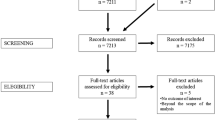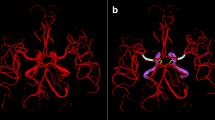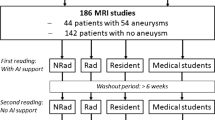Abstract
Purpose
It is often time-consuming to segment fine structures, such as the cerebral arteries from magnetic resonance imaging (MRI). Moreover, extracting anatomically abnormal structures is generally difficult. The segmentation workflow called threshold field painting was tested for its feasibility in morbid minute artery segmentation with special emphasis on time efficiency.
Methods
Seven patients with meningioma with ten-sided feeding arteries (n = 10) originating from middle meningeal arteries (MMA) were investigated by three experts of the conventional method for segmentation. The MRI time-of-flight sequence was utilized for the segmentation of each procedure. The tasks were accomplished using both the conventional method and the proposed method in random order. The task completion time and usability score were analyzed using the Wilcoxon signed-rank test.
Results
Except for one examinee (P = 0.06), the completion time significantly decreased (both P < 0.01) with the use of the proposed method. The average task completion time among the three examinees for the conventional method was 2.8 times longer than that for the proposed method. The usability score was generally in favor of the proposed method.
Conclusion
The normally nonexistent minute arteries, such as the MMA feeders, were deemed more efficiently segmented with the proposed method than with the conventional method. While automatic segmentation might be the ultimate solution, our semiautomatic method incorporating expert knowledge is expected to work as the practical solution.




Similar content being viewed by others
References
Yang DL, Xu QW, Che XM, Wu JS, Sun B (2009) Clinical evaluation and follow-up outcome of presurgical plan by Dextroscope: a prospective controlled study in patients with skull base tumors. Surg Neurol 72(6):682–689
Gandhe AJ, Hill DL, Studholme C, Hawkes DJ, Ruff CF, Cox TC, Gleeson MJ, Strong AJ (1994) Combined and three-dimensional rendered multimodal data for planning cranial base surgery: a prospective evaluation. Neurosurgery 35(3):463–470
Saito N, Kin T, Oyama H, Yoshino M, Nakagawa D, Shojima M, Imai H, Nakatomi H (2013) Surgical simulation of cerebrovascular disease with multimodal fusion 3-dimensional computer graphics. Neurosurgery 60(CN_suppl_1):24–29
Adams R, Bischof L (1994) Seeded region growing. IEEE Trans Pattern Anal Mach Intell 16(6):641–647
Hahn HK, Peitgen H-O (2000) The skull stripping problem in MRI solved by a single 3D watershed transform. In: International conference on medical image computing and computer-assisted intervention. Springer, pp 134–143
Hahn HK, Peitgen H-O (2003) IWT-interactive watershed transform: a hierarchical method for efficient interactive and automated segmentation of multidimensional gray-scale images. In: Proceedings of SPIE. pp 643–653
Ho P (2011) Image segmentation, Edited by Pei-Gee Peter Ho. Intech, Vienna
Maintz JA, Viergever MA (1998) A survey of medical image registration. Med Image Anal 2(1):1–36
Maurer CR, Fitzpatrick JM (1993) A review of medical image registration. In: Maciunas RJ (ed) Interactive image-guided neurosurgery. American Association of Neurological Surgeons, Park Ridge, pp 17–44
Otsu N (1979) A threshold selection method from gray-level histograms. IEEE Trans Syst Man Cybern 9(1):62–66
Shafait F, Keysers D, Breuel TM (2008) Efficient implementation of local adaptive thresholding techniques using integral images. DRR 6815:681510
Collignon A, Maes F, Delaere D, Vandermeulen D, Suetens P, Marchal G (1995) Automated multi-modality image registration based on information theory. In: Information processing in medical imaging, vol 6, pp 263–274
Maes F, Collignon A, Vandermeulen D, Marchal G, Suetens P (1997) Multimodality image registration by maximization of mutual information. IEEE Trans Med Imaging 16(2):187–198
Maes F, Vandermeulen D, Suetens P (2003) Medical image registration using mutual information. Proc IEEE 91(10):1699–1722
Yoshino M, Kin T, Nakatomi H, Oyama H, Saito N (2013) Presurgical planning of feeder resection with realistic three-dimensional virtual operation field in patient with cerebellopontine angle meningioma. Acta Neurochir 155(8):1391–1399
Kin T, Nakatomi H, Shono N, Nomura S, Saito T, Oyama H, Saito N (2017) Neurosurgical virtual reality simulation for brain tumor using high-definition computer graphics: a review of the literature. Neurol Med Chir 57(10):513–520
Ogiwara M, Shimizu T (2004) Surface rendered three-dimensional MR imaging for the evaluation of trigeminal neuralgia and hemifacial spasm. J Clin Neurosci 11(8):840–844
Rodt T, Bartling SO, Zajaczek JE, Vafa MA, Kapapa T, Majdani O, Krauss JK, Zumkeller M, Matthies H, Becker H, Kaminsky J (2006) Evaluation of surface and volume rendering in 3D-CT of facial fractures. Dentomaxillofac Radiol 35(4):227–231
Lorensen WE, Cline HE (1987) Marching cubes: a high resolution 3D surface construction algorithm. In: ACM siggraph computer graphics, vol 4. ACM, pp 163–169
Addis KA, Hopper KD, Iyriboz TA, Wise SW, Kasales CJ, Blebea JS, Mauger DT (2001) CT angiography: in vitro comparison of five reconstruction methods. Am J Roentgenol 177(5):1171–1176
Piotin M, Gailloud P, Bidaut L, Mandai S, Muster M, Moret J, Rüfenacht DA (2003) CT angiography, MR angiography and rotational digital subtraction angiography for volumetric assessment of intracranial aneurysms. An experimental study. Neuroradiology 45(6):404–409
Yoshino M, Kin T, Shojima M, Nakatomi H, Oyama H, Saito N (2012) A high-resolution method with increased matrix size can characterize small arteries around a giant aneurysm in three dimensions. Br J Neurosurg 26(6):927–928
Kin T, Nakatomi H, Shojima M, Tanaka M, Ino K, Mori H, Kunimatsu A, Oyama H, Saito N (2012) A new strategic neurosurgical planning tool for brainstem cavernous malformations using interactive computer graphics with multimodal fusion images. J Neurosurg 117(1):78–88
Igarashi T, Shono N, Kin T, Saito T (2016) Interactive Volume Segmentation with Threshold Field Painting. In: Proceedings of the 29th annual symposium on user interface software and technology. ACM, pp 403–413
Abe T, Matsumoto K, Hanakawa K, Homma H, Kawamura N, Ikeda H, Horichi Y, Hayashi T (1998) Role of 3D-TOF magnetic resonance angiography for intracranial meningioma. J Clin Neurosci 5(4):387–389
Uetani H, Akter M, Hirai T, Shigematsu Y, Kitajima M, Kai Y, Yano S, Nakamura H, Makino K, Azuma M, Murakami R, Yamashita Y (2013) Can 3T MR angiography replace DSA for the identification of arteries feeding intracranial meningiomas? Am J Neuroradiol 34(4):765–772
Kunii N, Ota T, Kin T, Kamada K, Morita A, Kawahara N, Saito N (2011) Angiographic classification of tumor attachment of meningiomas at the cerebellopontine angle. World Neurosurgery 75(1):114–121
Frangi AF, Niessen WJ, Vincken KL, Viergever MA (1998) Multiscale vessel enhancement filtering. In: International conference on medical image computing and computer-assisted intervention. Springer Berlin, pp 130–137
Lesage D, Angelini ED, Bloch I, Funka-Lea G (2009) A review of 3D vessel lumen segmentation techniques: Models, features and extraction schemes. Med Image Anal 13(6):819–845
Rudyanto RD, Kerkstra S, van Rikxoort EM, Fetita C, Brillet PY, Lefevre C, Xue W, Zhu X, Liang J, Il Ö, Ünay D, Kadipaşaoǧlu K, Estépar RSJ, Ross JC, Washko GR, Prieto JC, Hoyos MH, Orkisz M, Meine H, Hüllebrand M, Stöcker C, Mir FL, Naranjo V, Villanueva E, Staring M, Xiao C, Stoel BC, Fabijanska A, Smistad E, Elster AC, Lindseth F, Foruzan AH, Kiros R, Popuri K, Cobzas D, Jimenez-Carretero D, Santos A, Ledesma-Carbayo MJ, Helmberger M, Urschler M, Pienn M, Bosboom DGH, Campo A, Prokop M, de Jong PA, Ortiz-de-Solorzano C, Muñoz-Barrutia A, van Ginneken B (2014) Comparing algorithms for automated vessel segmentation in computed tomography scans of the lung: the VESSEL12 study. Med Image Anal 18(7):1217–1232
Jerman T, Pernus F, Likar B, Spiclin Z (2016) Enhancement of vascular structures in 3D and 2D angiographic images. IEEE Trans Med Imaging 35:2107–2118
Lamy J, Merveille O, Kerautret B, et al (2020) Vesselness filters: a survey with benchmarks applied to liver imaging. In: Proceedings—international conference on pattern recognition, pp 3528–3535
Li N, Zhou S, Wu Z et al (2020) Statistical modeling and knowledge-based segmentation of cerebral artery based on TOF-MRA and MR-T1. Comput Methods Programs Biomed 186:105110
Hilbert A, Madai VI, Akay EM et al (2020) BRAVE-NET: fully automated arterial brain vessel segmentation in patients with cerebrovascular disease. Front Artif Intell 3:1–14
Fan S, Bian Y, Chen H et al (2020) Unsupervised cerebrovascular segmentation of TOF-MRA images based on deep neural network and hidden Markov random field model. Front Neuroinform 13:1–10
Kai Y, Ji H, Morioka M, Yano S, Nakamura H, Makino K, Mizuno T, Takeshima H, Ji K (2007) Preoperative cellulose porous beads for therapeutic embolization of meningioma: provocation test and technical considerations. Neuroradiology 49(5):437–443
Klepaczko A, Szczypin P (2016) Simulation of MR angiography imaging for validation of cerebral arteries segmentation algorithms. Comput Methods Programs Biomed 137:293–309
Piccinelli M, Steinman DA, Hoi Y, Tong F, Veneziani A, Antiga L (2012) Automatic neck plane detection and 3D geometric characterization of aneurysmal sacs. Ann Biomed Eng 40(10):2188–2211
Funding
This research was supported by AMED under Grant Number 17he1602001h0001.
Author information
Authors and Affiliations
Corresponding author
Ethics declarations
Conflict of interest
The authors declare that they have no conflict of interest.
Ethical approval
All procedures performed in studies involving human participants were in accordance with the ethical standards of the institutional and/or national research committee and with the 1964 Helsinki declaration and its later amendments or comparable ethical standards.
Informed consent
Informed consent was obtained from all individual participants included in the study.
Additional information
Publisher's Note
Springer Nature remains neutral with regard to jurisdictional claims in published maps and institutional affiliations.
Supplementary Information
Below is the link to the electronic supplementary material.
Online Resource 1
Example of Multimodal Three-Dimensional Computer Graphics (TIFF 34866 kb)
Online Resource 2
Volume Paint Scheme “Three Datasets” The signal intensity, threshold value, and state (fixed or unfixed) for each voxel are stored in the system (EPS 7450 kb)
Online Resource 3
Graphical User Interface. The viewing point can be rotated using the right button drag, translated using the middle button drag, and zoomed in/out using the scroll wheel. “A” indicates the position of the buttons used to change the viewing angle to default settings (AP, HF, and LR projection, respectively). The threshold value of the unfixed voxels rendered in gray can be determined with the slider shown in “B.” “C” indicates the position of the buttons used to interact with the threshold field (TIFF 11928 kb)
Online Resource 4
Workflow of the Threshold Field Painting using the “Flood Fill” Function. a: When the threshold is set to the maximum at the initial state, nothing is rendered. b: With the threshold being lowered, the data are depicted. c, d, e: Bodies of the depicted data can be fixed using the “flood fill” function. f, g, h: The same procedure can be repeated for smaller structures. i: Finally, the threshold is set to the maximum to hide all unfixed structures (PNG 728 kb)
Online Resource 5
Workflow of the Threshold Field Painting using the “Brush” Function. a: The major trunks are depicted using the “flood fill” function. Thereafter, elongation of the branches can be started using the “brush” function. b, c, d: By changing the size of the spherical cage and the threshold field inside it manually, the elongation is achieved (PNG 369 kb)
Online Resource 6
Voxel Dimensions in Each Case. The voxel dimensions of the raw data utilized in each case of the user test are shown (PDF 38 kb)
Online Resource 7
Sample Image of Each Case. AP view and lateral view of each case were provided to the examinees prior to the start of each task (PNG 245 kb)
Rights and permissions
About this article
Cite this article
Shono, N., Igarashi, T., Kin, T. et al. Threshold field painting saves the time for segmentation of minute arteries. Int J CARS 17, 2121–2130 (2022). https://doi.org/10.1007/s11548-022-02682-4
Received:
Accepted:
Published:
Issue Date:
DOI: https://doi.org/10.1007/s11548-022-02682-4




